The Economics and Statistics Division maintains archives of previous publications for accountability purposes, but makes no updates to keep these documents current with the latest data revisions from Statistics Canada. As a result, information in older documents may not be accurate. Please exercise caution when referring to older documents. For the latest information and historical data, please contact the individual listed to the right.
<--- Return to Archive
For additional information relating to this article, please contact:
October 21, 2020ANALYSIS OF NOVA SCOTIA'S CONSUMER PRICE INDEX FOR SEPTEMBER 2020 TRENDS - SEPTEMBER 2020
In Nova Scotia the All-Items Consumer Price Index (CPI) decreased 0.7 per cent year-over-year in September 2020, while the national CPI increased 0.5 per cent. Compared to August 2020, monthly consumer prices were unchanged (0.0 per cent) in Nova Scotia and decreased 0.1 per cent nationally.
On a year-over-year basis, national CPI growth was higher in September (+0.5%) compared to August (+0.1%), with acceleration largely due to price changes in transportation, recreation, education and reading, and shelter components. Gasoline prices (-10.7%) were down year-over-year for the seventh consecutive month. Food prices growth (+1.6%) slowed compared to last month (+1.8%).
Tourist activity has remained weak since March 2020. Air transportation prices were down 3.2 per cent year-over-year in September compared to the 16.0 per cent year-over-year decline in August. Traveller accommodation prices were 26.5 per cent lower than September 2019.
Mortgage interest costs were up less in September (+0.1%) than August as mortgage rates face downward pressure following Bank of Canada's policy rate reductions in March. Lower interest rates has increased demand for single-family homes and there has been higher building material costs and low inventory of homes for sale and contributed to higher costs for new housing. The homeowner's replacement cost index rose 2.6 per cent year-over-year in September, up from the 2.0 per cent increase in August.
Impact of COVID-19 on the Consumer Price Index
Statistics Canada continued special CPI program measures for September 2020. In-person field collection was conducted via telephone or internet and supplemented with web scraping, transaction data, and administrative data. Due to COVID-19 impact on product availability, select sub-components of the CPI received temporary special imputations. The sub-indexes for travel tours, spectator entertainment, and recreational services were imputed from the monthly change in the all-items index - effectively removing the impact of these goods and services on the CPI. Air transportation that was purchased but cancelled is excluded from calculations. Additional details can be found in the technical supplement.
Two provinces reported a year-over-year decline in the All-Item CPI: Nova Scotia (-0.7%) and New Brunswick (-0.2%). On a year-over year basis, CPI increase was largest in Alberta (+1.5%).

The main contributors to the monthly (September 2020 vs. August 2020) NS CPI movement were:
- Rent (+1.9%)
- Tuition fees (+3.1%)
- Homeowners' replacement cost (+1.6%)
- Inter-city transportation (-7.0%)
- Telephone services (-3.0%)
- Fresh vegetables (-5.3%)
Contributors to the annual (September 2020 vs. September 2019) NS CPI movement were:
- Purchase and leasing of passenger vehicles (+2.9%)
- Passenger vehicle insurance premiums (+9.8%)
- Homeowners' replacement cost (+4.8%)
- Gasoline (-16.1%)
- Traveller accommodation (-39.3%)
- Fuel oil and other fuels (-20.9%)
Nova Scotia's consumer price inflation (year-over-year growth in CPI) excluding food and energy was 0.2 per cent in September. All provinces reported year-over-year increases with the national rate at 0.8 per cent. Prince Edward Island (+1.6%) reported the largest price level increases, while Nova Scotia (+0.2%) reported the smallest increases.
Compared to the previous month, the CPI excluding food and energy was up or unchanged in all provinces.
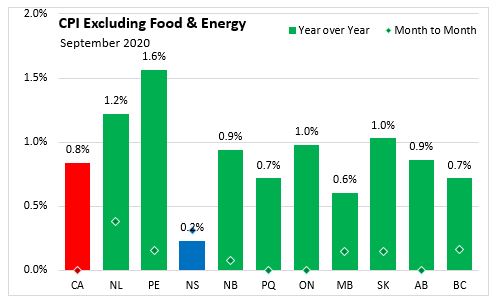
The CPI for food in Nova Scotia increased 1.2 per cent year-over-year in September, slower than 1.9 per cent increase last month. Food prices year-over-year growth was positive in all provinces with the national average at 1.6 per cent. Compared to last month, food prices declined in all provinces and were down 0.8 per cent for Canada and 1.2 per cent for Nova Scotia. Prince Edward Island (+2.5%) and Ontario (+1.8) had the largest percentage increases in food prices compared to September 2019. Food prices increased in Newfoundland and Labrador by only 0.3 per cent compared to a year ago.
On a monthly basis, all provinces experienced decreases in food prices for a second consecutive month. Compared to last month food prices were down 0.8 per cent in Canada and 1.2 per cent in Nova Scotia.

In August, the Nova Scotia energy price index decreased 11.3 per cent compared to a year ago. Year-over-year, the energy price index decreased in every province except Alberta, with a national average decline of 5.6 per cent. The largest annual decline was in Prince Edward Island (-14.5%). Nationally, prices for fuel oil and other fuels were 20.7 per cent lower compared to last year.
Monthly energy prices (September 2020 vs. August 2020) were down in eight of ten provinces, with the largest decline in Ontario (-1.0%) and Alberta increasing 7.3 per cent. Energy prices were down in Nova Scotia by 0.3 per cent compared to August.

Year-over-year, Nova Scotia had the largest decline in the consumer price index for shelter in September, with a decline of 0.3 per cent. For all of Canada, the shelter price index increased 1.7 per cent, with the largest increase in Ontario (+2.2%) and Alberta (+2.2%).
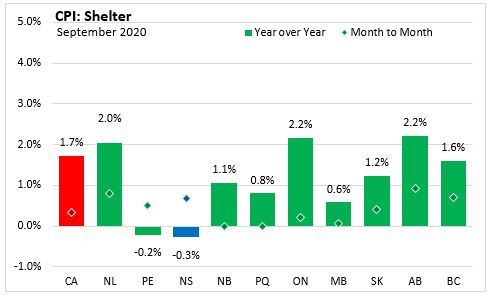
Nova Scotia's consumer price inflation (year-over-year growth in CPI) excluding energy was 0.4 per cent in September compared to a national rate of 1.0 per cent. The rate of increase in the CPI excluding energy index was similar across most provinces at around 1.0 per cent year-over-year, with the exceptions being Prince Edward Island (+1.7%) and Nova Scotia (+0.4%).
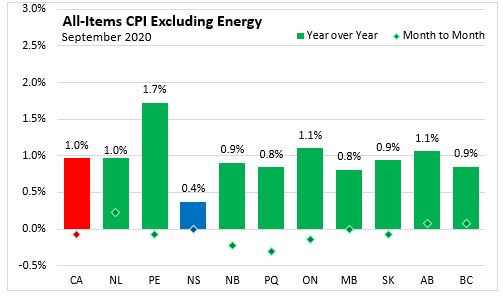
Major Components for September 2020
The following table shows the price increases specific to Nova Scotia for the major components of the CPI this month:
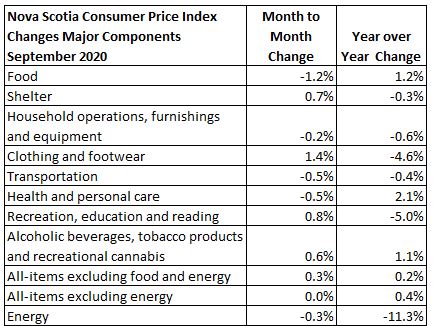
Long Run Trends
In September 2020, the All-Items CPI year-over-year inflation rate for Nova Scotia was -0.7 per cent, below Canada's at 0.5 per cent. Nova Scotia's annual inflation has mostly been below the Canadian average since mid-2014, with the exception of only a few months. While month-to-month movements in the indices can be different, over time they generally follow the same overall trend. Nova Scotia’s year-over-year CPI inflation is currently at levels not seen since 2009.

Annual inflation for the CPI excluding food and energy in Nova Scotia (+0.2%) was below than the national rate (+0.8%) in September 2020.
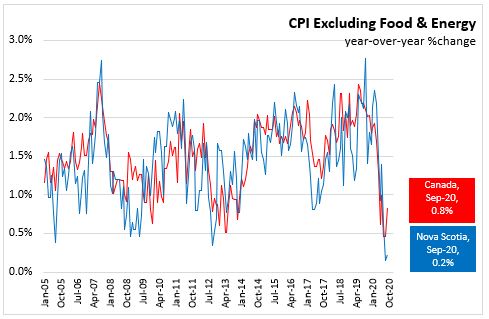
Bank of Canada's preferred measures of core inflation
Compared to September 2019, CPI-Common increased 1.5 per cent, CPI-Median rose 1.9 per cent and CPI-Trim was up 1.8 per cent in Canada. All-items CPI excluding eight of the most volatile components as defined by the Bank of Canada, and excluding the effect of changes in indirect taxes (formerly referred to as CPIX), rose 1.0 per cent, year-over-year.
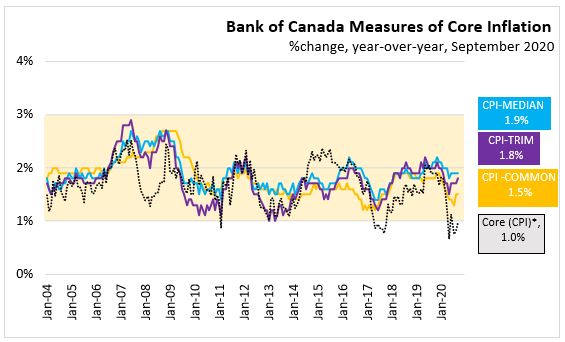
Appendix Tables and Charts
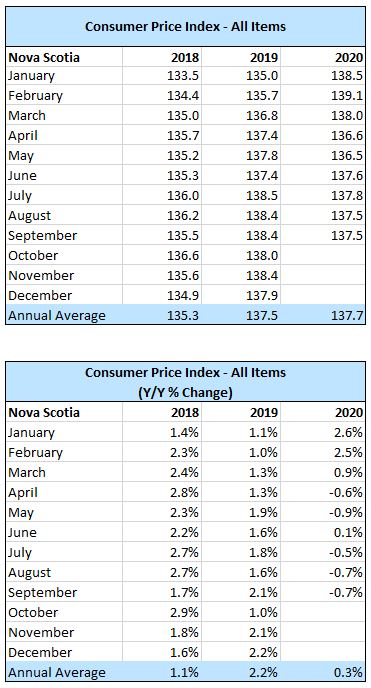
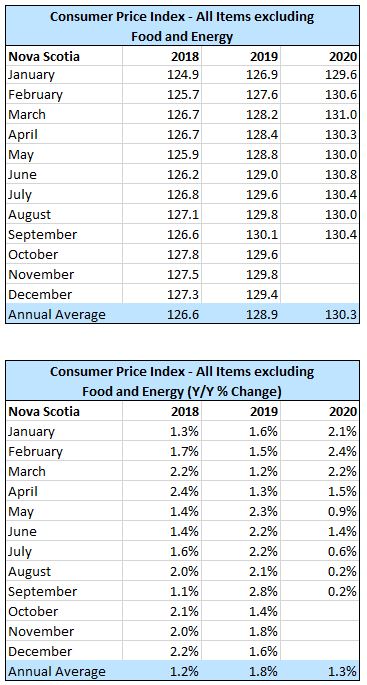
Source: Statistics Canada data portal: Tables 18-10-0004-01 and 18-10-0256-01
<--- Return to Archive